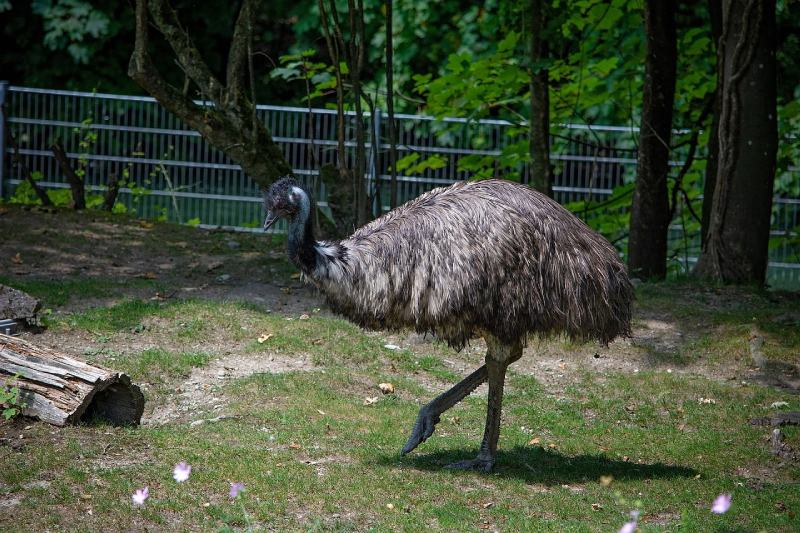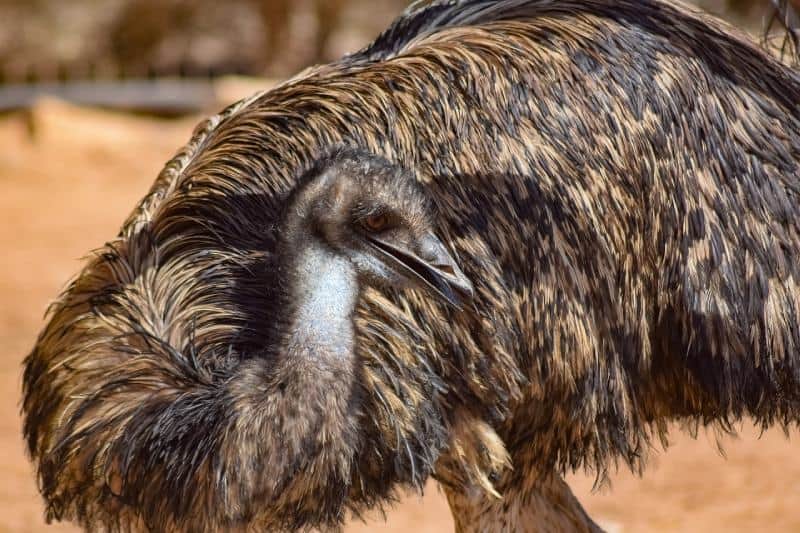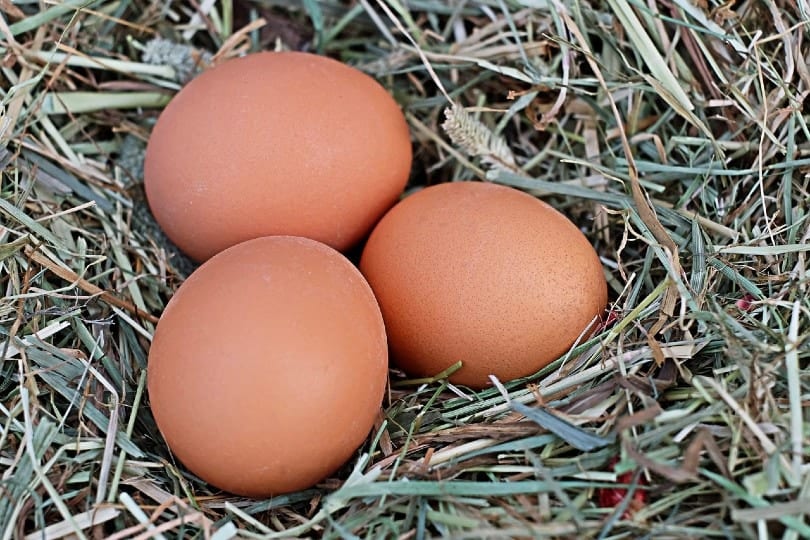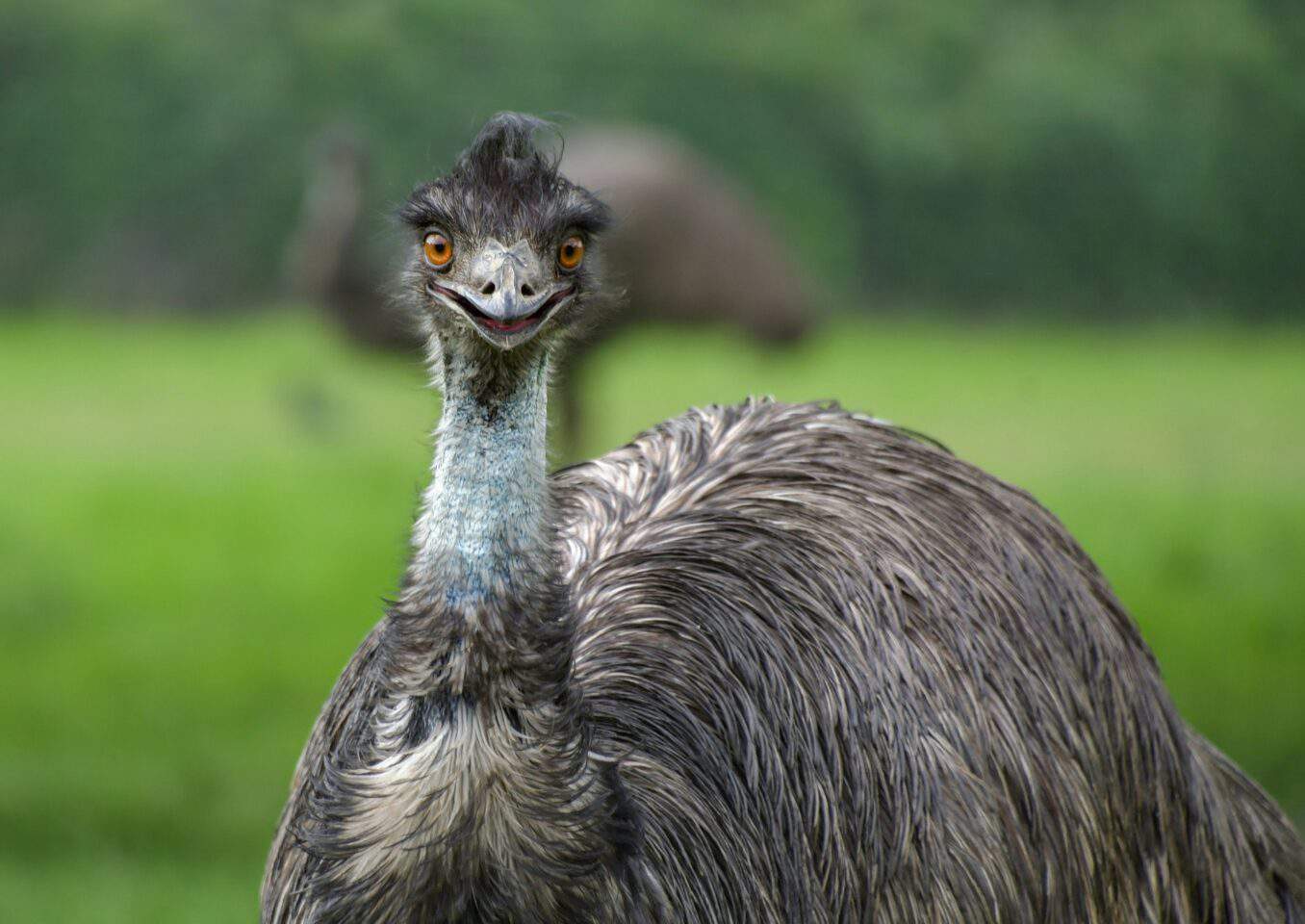As the second largest bird in the world today, Emus have a considerable body mass to maintain whilst traveling long distances in an oftentimes harsh climate.
Beaten out for the top spot by the statuesque ostrich, which comes in at around 8 feet tall and weighing a formidable 350 pounds, the emu’s stats are still pretty impressive. Averaging 6 feet tall and 130 pounds, it’s hard to think of them being in any way related to your average parakeet or finch! They are largely solitary and nomadic, often traveling vast distances to find food and water, sometimes at speeds of up to 30 miles per hour.
Native to Australia, these fascinating and sometimes comical creatures have made their way onto the farming scene as an unusual meat source for humans, and more recently, a unique protein source for dogs with food-based allergies. This raises the question: What do emus eat?
True omnivores, emus will eat just about anything and are infamous raiders of unsuspecting picnickers in Australia. In the absence of sandwiches and cakes, the diet of the wild emu is made up of quite a variety, depending on what is available at the time.
Click to Skip Ahead:

What Do Emus Eat in the Wild?
Emus are omnivores, but they typically eat a plant-based diet. Their preference is for fresh grasses and seeds, as well as some insects; but they are also very opportunistic and will consume anything they come across, sometimes even foraging from the droppings of other animals!
Even though they are mostly herbivorous, their diet requires a protein intake between 15%–20%, and they select insects and other small creatures that are high in protein to meet those needs. Emus know to avoid dangerous species like snakes, but they will happily eat a lizard or a small rodent.

1. Plants
Plants are the primary source of food for Emus in the wild. Emus prefer seeds, leaves, young shoots, herbs, fruits, and vegetables; their favorite meals include the Acacia and casuarina plants. Living in an environment prone to long periods of drought, these giant birds have a highly adaptable palate and will feast on what is available, or travel long distances to find food. In severe conditions, these resilient birds have been known to survive for up to 2 months without food, provided they can find water.
The emu plays a crucial role in their ecosystem as a master of seed dispersion. Often, seeds are consumed, and as the emu forages, it leaves behind fertilized seed-carrying deposits in its excrement.
2. Insects & Arthropods
Emus source some of their protein from insects such as grasshoppers and beetles. Their diet requires high amounts of protein to support and strengthen their muscles, so Emus often eat insects such as caterpillars, ants, crickets and cockroaches, even though they prefer plants and grass.
They will also go on the hunt for arthropods such as centipedes, millipedes or scorpions, which are highly nutritious, making them worth the effort for Emus.
3. Reptiles
As we know, emus prefer to eat plants and insects but generally eat anything available to them. This includes reptiles and small mammals. Emus commonly eat lizards because they don’t have parental protection so their young are generally easy prey.

4. Eggs
If an emu is fortunate enough to come across an unguarded bird nest or clutch of reptile eggs, this treat packed with fats and protein is far too tempting to pass up, so a hungry emu will make short work of these.
What Do Captive Emus Eat?
Captive Emus are an entirely different matter. They may be kept as part of a zoological collection, but are also farmed for their meat in many places around the world. Most of their diet is still mostly plant matter, but will include some other food sources and animal byproducts that wouldn’t be acquired in the wild.
5. Fruits
Emus love fruit, and it is a common food fed in captivity. Fruits fed to emus in captivity include berries, kiwis, apples, grapefruits, melons, and grapes. Fruit is usually abundant and easily accessible, making it a good food source for captive emus.

6. Seeds
Emus eat plant components with the highest concentration of nutrients. Emus love seeds, such as grass seeds, sunflower seeds, corn seeds, and peanuts. These tough items are broken down easily in their powerful gizzards with the help of stones they swallow (more on this later!).
7. Vegetables
Emus also consume carrots, cabbage, potatoes, spinach, fresh beets, and other greens.
Two of the essential vegetables that form part of a captive Emu’s diet are romaine lettuce and kale. These are particularly beneficial due to their high fiber content and being rich in nutrients, containing key minerals and vitamins such as calcium, magnesium, phosphorus and B Vitamins.
8. Grains
Farmed emus will often be fed various grains, but their preference is wheat. They are usually given oats, barley, millet, bran, and yeast. Emy farmers that grow their own grains are careful with their placement as emus will happily destroy a crop to eat its favorite grain if given the chance!

9. Meat and Kitchen Scraps
Emus will eat most kitchen scraps, from bread to pasta, a bit of leftover casserole, or anything else that would otherwise end up in the compost heap. A tiny bit of meat can provide them with protein, and they undoubtedly won’t object. They will even try to eat any small items you leave lying around, like your car keys or small toys!
10. Bone Meal
Captive emus will sometimes be fed bone meal to ensure they are receiving appropriate levels of calcium, phosphorus, and trace minerals.
11. Chicken Eggs
Chicken eggs are a great protein source for emus and a healthy addition to their diet that is readily available.

12. Mice and Lizards
Captive emus do not dine on insects as often as emus in the wild, but they can come across mice and lizards. Emus often catch lizards in the wild as they are easy prey, and it’s the same for captive emus.
Now you’re probably wondering about those stones we mentioned earlier. That brings us to number 13 on the list: stones.
13. Stones!
In the wild, emus will swallow stones that sit in their very muscular gizzard to help grind up food, ready for digestion. The gizzard is a sort of “pre-stomach” for birds to break down their food before it begins digestion in the stomach, because they don’t have teeth to chew it. Birds that eat softer foods like fruit or nectar tend to have very tiny gizzards, but in birds that consume more tough or fibrous foods, like the emu, this organ is very powerful. They will periodically swallow stones that stay in the gizzard for long periods of time to help crush and grind the food.
Essentially, it works the same as a pestle and mortar works to grind up food. As the stones degrade over time and are expelled, the birds ingest additional stones to replenish their supply. Emus can swallow stones as big as 1.6 oz, and at any time, they can have as much as 1.642 pounds of stones in the gizzards!
So technically, these aren’t actually a food item, but they are swallowed so we’ve included them on our list.

How Much Do Emus Need to Eat?
Because wild emus live in a challenging environment, they spend the majority of their time foraging and grazing. They can travel up to 15 miles daily in search of food and water, but fortunately, they can go weeks without food. Emus can store a lot of fat in their body, so when food is in short supply, they can lose up to half of their body weight but still survive for weeks. Once they have found a food source, they will eat and store extra and continue searching for food.
Emus that live in captivity do not need to eat as much due to the steady supply of food. An adult Emu will typically eat about 1.5 pounds of feed per day, but that also depends on how much they have grazed.

Conclusion
Emus are fascinating birds that have adapted to living in an environment that can be extremely harsh at times, able to survive weeks without eating, and travel for miles foraging for food. Their diet list could reach as long as the distances they cover as they really will eat just about anything! While they are omnivorous, they prefer plants and grass but will also eat insects, reptiles and small mammals as a source of protein. Their lack of specialized dietary needs has made them a relatively easy species to keep in captivity or farm, happy to eat virtually anything offered, even the inedible!
Featured Image Credit: christels, Pixabay
